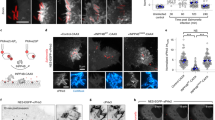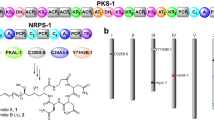Abstract
The first isolation of a naturally occurring phosphonate in 19591 led rapidly to the discovery of a variety of metabolites containing a phosphorus–carbon bond2. Phosphonates have been found in bacteria, fungi, and higher organisms such as the snail schistosome vector Biomphalaria2–6. The biosynthetic path to the P–C bond has, however, remained undefined. Thus although it was shown twenty years ago that the isotope label from [14C]glucose7,8 or from [32P]phosphoenolpyruvate8 is incorporated into 2-aminoethylphosphonate by the protozoan Tetrahymena pyriformis, the presumed stoichiometric transformation of phosphoenolpyruvate to phosphonopyruvate has never been demonstrated. Low conversions of phosphoenolpyruvate into 2-aminoethylphosphonate and the trapping of phosphonopyruvate from phosphoenolpyruvate have been reported9–12, but these reactions have not proved reproducible, and the existence of the critical enzyme, phosphoenolpyruvate phosphonomutase, has remained notional. We now report experiments that resolve this enigma, and describe the isolation and characterization of the pure mutase from T. pyriformis.
This is a preview of subscription content, access via your institution
Access options
Subscribe to this journal
Receive 51 print issues and online access
$199.00 per year
only $3.90 per issue
Buy this article
- Purchase on Springer Link
- Instant access to full article PDF
Prices may be subject to local taxes which are calculated during checkout
Similar content being viewed by others
References
Horiguchi, M. & Kandatsu, M. Nature 184, 901–902 (1959).
Hori, T., Horiguchi, M. & Hayashi, A. Biochemistry of Natural C—P Compounds (Maruzen, Tokyo, 1984).
Mastalerz, P. in Natural Products Chemistry (eds Zalewski, R. I. & Skolik, J. J.) 171–184 (Elsevier, Amsterdam, 1984).
Thompson, S. N. & Lee, R. W. K. J. Parasit. 71, 652–663 (1985).
Seto, H. et al. J. Antibiot. 35, 1719–1721 (1982).
Imai, S. et al. J. Antibiot. 37, 1505–1508 (1984).
Trebst, A. & Geike, F. Z. Naturforsch. 22, 989–991 (1967).
Warren, W. A. Biochim. biophys. Acta 156, 340–346 (1968).
Horiguchi, M. Biochim. biophys. Acta 261, 102–113 (1972).
Horiguchi, M. & Rosenberg, H. Biochim. biophys. Acta 404, 333–340 (1975).
Takada, T. & Horiguchi, M. Biochim. biophys. Acta 964, 113–115 (1988).
Barry, R. & Dunaway-Mariano, D. Fedn. Proc. Am. Soc. exp. Biol. 42, 1961 (1983).
Barry, R. J., Bowman, E., McQueney, M. & Dunaway-Mariano, D. Biochem. biophys. Res. Commun. 153, 177–182 (1988).
Anderson, V. E., Weiss, P. M. & Cleland, W. W. Biochemistry 23, 2779–2786 (1984).
Author information
Authors and Affiliations
Rights and permissions
About this article
Cite this article
Seidel, H., Freeman, S., Seto, H. et al. Phosphonate biosynthesis: isolation of the enzyme responsible for the formation of a carbon–phosphorus bond. Nature 335, 457–458 (1988). https://doi.org/10.1038/335457a0
Received:
Accepted:
Issue Date:
DOI: https://doi.org/10.1038/335457a0
This article is cited by
-
Aerobic oxidation of methane significantly reduces global diffusive methane emissions from shallow marine waters
Nature Communications (2022)
-
Genomics-enabled discovery of phosphonate natural products and their biosynthetic pathways
Journal of Industrial Microbiology and Biotechnology (2014)
-
Organophosphonates revealed: new insights into the microbial metabolism of ancient molecules
Nature Reviews Microbiology (2013)
-
Mechanistic studies of an unprecedented enzyme-catalysed 1,2-phosphono-migration reaction
Nature (2013)
-
Cloning and nucleotide sequence of fosfomycin biosynthetic genes of Streptomyces wedmorensis
Molecular and General Genetics MGG (1995)
Comments
By submitting a comment you agree to abide by our Terms and Community Guidelines. If you find something abusive or that does not comply with our terms or guidelines please flag it as inappropriate.



